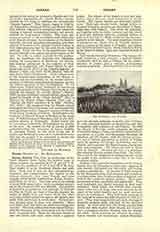

Canary Islands, the, form an archipelago in the North Atlantic Ocean facing the western coast of Africa, between the parallels of 27° 4′ and 29° 3′ N. lat., and the meridians of 13° 3′ and 18° 2′ W. long. They consist of seven important islands and some islets. From east to west the first encountered are Lanzarote and Fuerteventura, the nearest to the African continent; then come Tenerife and Gran Canaria, while farther westward are Palma, Gomera, and Hierro (or Ferro). The total area of the islands is about 3256 square miles; their population, according to the census of 1900, was 358,564. The country in general is mountainous and volcanic; in Tenerife the Pico de Teyde, or Peak of Tenerife, reaches the height of 12,200 feet, and towers above the other mountains which extend throughout the islands, generally from northeast to southwest. Natural caverns abound, some of them very extensive. There is no great river, but there are numerous springs and torrents. The fauna differs little from that of Europe, with the exception of the dromedary and the thistle-finch, or canary-bird. There are extensive forests of pine and laurel, and some stems reach a gigantic height. The climate of the islands is mild and salubrious; hence they are much frequented as winter resorts. The Canary Islands are essentially agricultural. Their soil, usually fertile, though subject to frequent droughts, produces an abundance of fruits, sugar-cane, and tobacco. The wines are exquisite, and together with the fruits, tobacco, and fish, which is good and plentiful, form the principal articles of commerce for export. Much cochineal, also, is manufactured in the islands. The most important centers of population are: Santa Cruz de Tenerife, Orotava, and La Laguna in the island of Tenerife; Las Palmas and Arracife in Gran Canaria; Santa Cruz de la Palma in the island of Palma; Quia and Valverde in that of Hierro.
Civil and Ecclesiastical Divisions.—The Canary Islands constitute a civil province, a judicial district (audiencia), with its seat at Palmas, for the administration of justice, and a military governorship (captaincy-general). Ecclesiastically they are divided into two dioceses, suffragan of Seville, that of Tenerife, with episcopal residence at Santa Cruz, and that of Canaries, with residence at Las Palmas. In 1906 the Diocese of Tenerife, which comprises the islands of Tenerife, Gomera, Palma, and Hierro, had a Catholic population of 171,045, with 62 parishes, 86 priests, 60 churches, and 167 chapels; while the Diocese of Canaries had a Catholic population of 83,378, 50 Protestants, 42 parishes, 103 priests, 42 churches, and 113 chapels, and comprises the Grand Canary, Fuerteventura, and Lanzarote. The courts are held at Santa Cruz de Tenerife. All ports are free, i.e. merchandise entering them is exempt from duty. The inhabitants satisfy the obligation of military service, not in the ranks of the peninsular army, but in the local territorial militia.
History.—The primitive populations of the Canary Islands were the Guanches, a white race, vigorous, of high stature, fair-haired and blue-eyed, and leading mostly a pastoral life. At the time of their conquest by the Europeans they used weapons and utensils of wood and stone, were clothed in skins of animals, and lived in the numerous natural grottos. Their ornaments were of bone, sea-shells, and baked clay. They were hospitable and deeply attached to their independence. Each island was divided into separate states, ruled over by kings, who were assisted by the chiefs of the noble families and the most esteemed priests or soothsayers. They held their meetings in the open air in places specially intended for this purpose. They were monotheists and made offerings of domestic animals, milk, and fruit to the Supreme Being. At some early date Old World peoples from Africa and Asia reached these islands and founded there permanent colonies, blending with the aboriginal stock. Their invasions are attested by archaeological remains and inscriptions; certain Numidian inscriptions on the rocks of Gran Canaria and Hierro are similar to those discovered in Africa. An Aragonese fleet explored the islands in 1330. Another Castilian coasting expedition, sent forth by merchants of Seville and Biscay, disembarked, in 1385, in Lanzarote and vanquished the aborigines, but did not found any lasting settlement. This was not accomplished until the expedition of Jean de Bethencourt, a French nobleman, who in virtue of a mission confided to him by the King of Castile, Henry III, conquered, from 1402 to 1405, the islands of Lanzarote, Fuerteventura, Gomera, and Hierro. The conquest of Gran Canaria, Palma, and Tenerife was effected during the reign of the Catholic sovereigns, from 1478 to 1495, by Diego Garcia de Herrera, Pedro de Vera, and Alonso Fernandez de Lugo, but not without heroic resistance on the part of the Guanches.
Combined action on the part of Church and State helped to Christianize and civilize the Guanches, and gave excellent results. The people abandoned their heathen practices and willingly embraced Christianity. The Catholic priest was always a brave protector of the natives against the vexations to which, in the early days of the conquest, they were occasionally exposed at the hands of their conquerors. Among the most deserving ecclesiastics in this respect is Don Juan de Frias, Bishop of Gran Canaria at the close of the fifteenth century. The Catholic sovereigns dictated wise provisional measures in order to protect the lives and farms of the aborigines, and after the conclusion of the war gave them the right to participate in the government of the islands. Owing to frequent marriages between Spaniards and Guanches, the fusion of both races was finally accomplished, and this community of affection and interest became a powerful factor in the economic prosperity of the islands.
EDUARDO DE HINOJOSA

